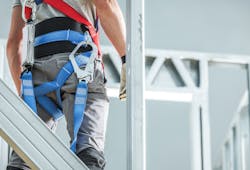OSHA reports that fall protection (1926.501) was the number one most frequently cited standard in FY 2022. Here are the top 5 subparagraphs cited under fall protection.
- 1926.501(b)(13)
- 1926.501(b)(1)
- 1926.501(b)(10)
- 1926.501(b)(11)
- 1926.501(b)(4)
What are these, and how do you address them?
1926.501(b)(13) states: “Residential construction. Each employee engaged in residential construction activities 6 ft or more above lower levels shall be protected by a guard rail system, safety net system, or personal fall arrest system unless another provision in paragraph (b) of this section provides for an alternative fall protection measure.” An exception exists if the employer can demonstrate that such protection is infeasible or creates a greater hazard (but the employer must come up with something to mitigate the danger).
A fair number of these citations are handed out to fly by night roofing companies, and most single-family or duplex home electrical work is not done at elevation. However, roof-mounted solar panel installations, eave lights, (some) security sensors, and roof-mounted HVAC units are among electrical installations performed at elevation in these types of dwellings. And of course high-rise apartments may involve considerable rough-in work at elevation along with elevated exterior lighting and security devices installed remote from the building.
To address fall protection for residential construction, it may be most cost effective to try to assign such work to a designated crew that has been trained on fall protection and that has been supplied with the necessary equipment.
1926.501(b)(1) states: “Unprotected sides and edges.” Ensure that each employee on a walking or working surface at elevation (6 ft or more above the lower level) is protected from a fall by guardrail systems, safety net systems, or personal fall arrest systems.
To address this issue, identify all elevated surfaces that do not have guardrail systems or safety net systems. Give them a special designation and limited access. Limit the access both physically (if possible) and administratively. Physical restriction can be a locked door or a barrier chain. Administrative restriction means, for example, you have a system whereby people must get a supervisor’s permission to walk or work on that surface, and the supervisor has a checklist of requirements (e.g., PPE has been issued, and the worker in question is qualified to use it) to meet.
We will continue with 1926.501(b)(10) in Part 3.
About the Author

Mark Lamendola
Mark is an expert in maintenance management, having racked up an impressive track record during his time working in the field. He also has extensive knowledge of, and practical expertise with, the National Electrical Code (NEC). Through his consulting business, he provides articles and training materials on electrical topics, specializing in making difficult subjects easy to understand and focusing on the practical aspects of electrical work.
Prior to starting his own business, Mark served as the Technical Editor on EC&M for six years, worked three years in nuclear maintenance, six years as a contract project engineer/project manager, three years as a systems engineer, and three years in plant maintenance management.
Mark earned an AAS degree from Rock Valley College, a BSEET from Columbia Pacific University, and an MBA from Lake Erie College. He’s also completed several related certifications over the years and even was formerly licensed as a Master Electrician. He is a Senior Member of the IEEE and past Chairman of the Kansas City Chapters of both the IEEE and the IEEE Computer Society. Mark also served as the program director for, a board member of, and webmaster of, the Midwest Chapter of the 7x24 Exchange. He has also held memberships with the following organizations: NETA, NFPA, International Association of Webmasters, and Institute of Certified Professional Managers.
